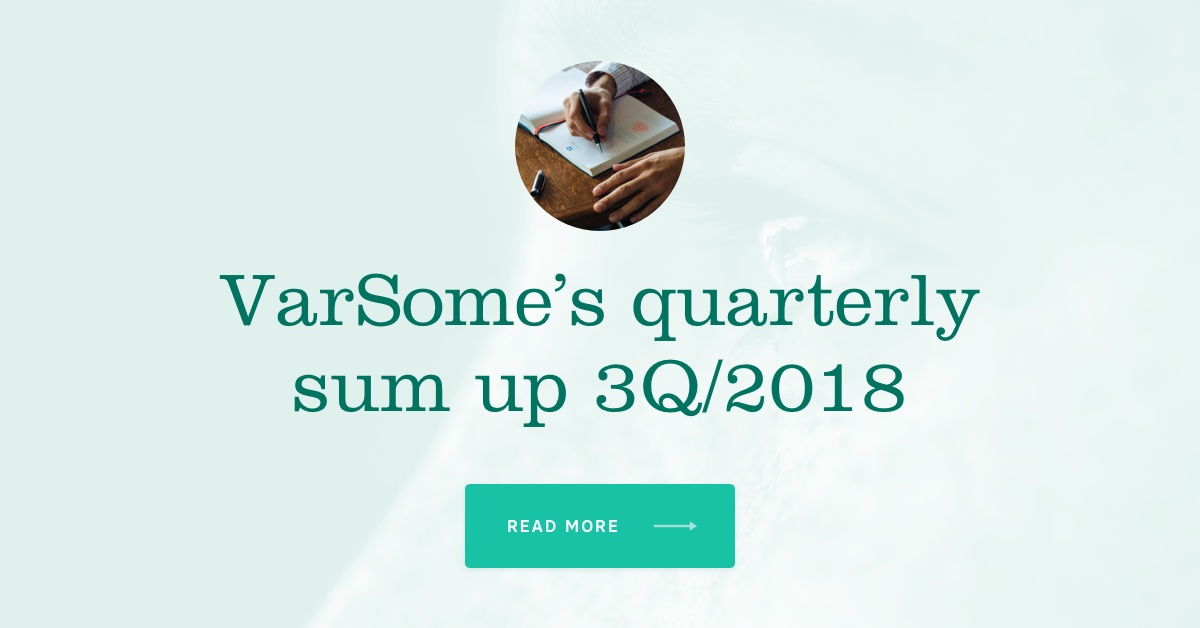
I’d like to welcome you to VarSome’s first quarterly sum up. But before we start, I’d like to take this opportunity to introduce myself as a new member of VarSome’s team serving the position of Head of Business Development. I believe my scientific background, combined with my past experience from the world of Software as a Service technologies and multichannel marketing, provide a solid ground for my future contributions to the project. VarSome is a unique community project in the field of human genetics and genomics and I feel honored to be a part of it.
But let’s get back to the point! Indeed, the past quarter has been quite busy in many ways. Since its launch in 2016, VarSome has experienced incredible compound monthly growth of more than 20%, and as of October 2018 has served over 85’000 users worldwide. We are humbled and grateful to the growing VarSome community for trusting us! Our multi-disciplinary team has been working hard to bring to you a host of new features. I’d like to highlight some of the latest additions to VarSome:
- Full-Text Search expands the existing search functionality of VarSome, enabling you to search not only for variants, but also to perform word searches over the entire contents of VarSome, such as articles, diseases, phenotypes, genes and content provided by its community.
- ACMG Classification was further improved based on the feedback from VarSome users and its scientific and clinical advisors. We have added tests for conservation using GERP, improved repeat regions, adjusted some of the thresholds used, implemented two new rules BP3 and BP7, and improved the explanations when rules are not triggered.
- Monarch Disease Ontology and PanelApp from Genomics England were added to VarSome. To date, over 30 integrated and cross-referenced genomics resources are available.
- We have also re-launched our main web presentation and blog, to provide you with the latest information and updates on the project.
Over the past couple of months, many VarSome users have asked whether we could add the possibility to annotate a whole VCF file, which made us realize VarSome users don’t yet know about Saphetor, our fully-flagged clinically certified SaaS tool, designed specifically for analysis of NGS data, for whole genomes, exomes, and gene panels, for individual samples, trios, families, and cohorts. If you are looking for such a tool, I encourage you to check out our new website and learn more about it.
Nevertheless, the answer to that question is strong YES! At the most important world congress for human genetics ASHG in San Diego, we announced VarSome Pro, the professional version of VarSome, enriched by several features that VarSome users have been requesting for quite a while. Namely, on VarSome Pro you will be able very soon to upload and annotate an entire VCF file, filter out variants using sophisticated filters, and download the resulting, fully annotated VCF file, including ACMG classifications. We are also working very hard on VarSome Clinical, where you will be able to upload the whole FASTQ file and get a clinical report at the end of the process.
We have also exhibited at many conferences and tradeshows around the clock, such as BioIT World Expo in Boston, ESHG in Milano, BioSpain in Seville, NVHG in Papendal, ASHG in San Diego, AMP in San Antonio and Bio-Europe in Copenhagen. We also participated in NGS in DNA Diagnostics course held at Medical Faculty of Erasmus University in Rotterdam, The Netherlands. One thing is clear – VarSome is becoming a recognized tool in the world of human genetics and genomics. Moreover, recently we have published an article in Bioinformatics journal of Oxford Academic, so if you use VarSome for your work please cite it in your articles and all other communications.
Speaking of Saphetor, our professional tool for NGS data analysis, we have started multiple collaborations with hospitals, laboratories and biotech companies in Spain, Italy, Switzerland, Greece, Czech Republic, USA, and Mexico; more are to come in the next couple of months.
I would be very glad to discuss with you how we can help you to analyze your NGS data! Don’t hesitate to reach out to us!

